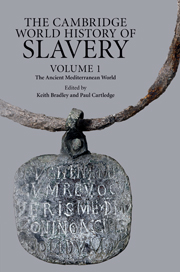Book contents
- Frontmatter
- Contents
- Series editors' introduction
- List of figures
- Acknowledgements
- Introduction
- 1 Slavery in the ancient Near East
- 2 Slaves in Greek literary culture
- 3 Classical Athens
- 4 The Helots: a contemporary review
- 5 Slavery and economy in the Greek world
- 6 The slave supply in classical Greece
- 7 Slavery and the Greek family
- 8 Resistance among chattel slaves in the classical Greek world
- 9 Archaeology and Greek slavery
- 10 Slavery in the Hellenistic world
- 11 Slavery and Roman literary culture
- 12 Slavery in the Roman Republic
- 13 Slavery Under the Principate
- 14 The Roman slave supply
- 15 Slave labour and Roman society
- 16 Slavery and the Roman family
- 17 Resisting slavery at Rome
- 18 Slavery and Roman material culture
- 19 Slavery and Roman law
- 20 Slavery and the Jews
- 21 Slavery and the rise of Christianity
- 22 Slavery in the late Roman world
- Bibliography
- General index
- Index of ancient passages cited
- Index of inscriptions and papyri
- Index of Jewish and Christian Literature Cited
9 - Archaeology and Greek slavery
Published online by Cambridge University Press: 28 September 2011
- Frontmatter
- Contents
- Series editors' introduction
- List of figures
- Acknowledgements
- Introduction
- 1 Slavery in the ancient Near East
- 2 Slaves in Greek literary culture
- 3 Classical Athens
- 4 The Helots: a contemporary review
- 5 Slavery and economy in the Greek world
- 6 The slave supply in classical Greece
- 7 Slavery and the Greek family
- 8 Resistance among chattel slaves in the classical Greek world
- 9 Archaeology and Greek slavery
- 10 Slavery in the Hellenistic world
- 11 Slavery and Roman literary culture
- 12 Slavery in the Roman Republic
- 13 Slavery Under the Principate
- 14 The Roman slave supply
- 15 Slave labour and Roman society
- 16 Slavery and the Roman family
- 17 Resisting slavery at Rome
- 18 Slavery and Roman material culture
- 19 Slavery and Roman law
- 20 Slavery and the Jews
- 21 Slavery and the rise of Christianity
- 22 Slavery in the late Roman world
- Bibliography
- General index
- Index of ancient passages cited
- Index of inscriptions and papyri
- Index of Jewish and Christian Literature Cited
Summary
INTRODUCTION
What can archaeologists contribute to the study of Greek slavery? First, we need to know just what it is we are studying. According to Peter Garnsey (1996: 1), ‘A slave was property. The slave-owner's rights over his slave-property were total, covering the person as well as the labour of the slave. The slave was kinless, stripped of his or her old social identity in the process of capture, sale and deracination, and denied the capacity to forge new bonds of kinship through marriage alliance. These are the three basic components of slavery.’ Some ancient historians dispute particular elements of this definition or merge chattel slavery into a broader category of unfree labour, but few ancient historians dissent strongly from Garnsey's phrasing. This immediately raises the issue that dominates this chapter: archaeologists face severe problems operationalising any plausible definition of ancient Greek slavery. Slavery was a legal category, driven by notions of property; and despite considerable ingenuity, archaeologists cannot dig up property rights. Moses Finley (1985: 25) emphasised this in his influential discussion of the complicated arrangements involving leases, labour and capital in Roman pottery kilns, insisting that ‘archaeological evidence or archaeological analysis by itself cannot possibly uncover the legal or economic structure revealed by the Oxyrhynchus papyri or the alternative structures in Arezzo, Puteoli, Lezoux or North Africa’.
- Type
- Chapter
- Information
- The Cambridge World History of Slavery , pp. 176 - 193Publisher: Cambridge University PressPrint publication year: 2011
- 7
- Cited by



